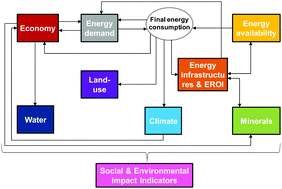当前位置:
X-MOL 学术
›
Energy Environ. Sci.
›
论文详情
Our official English website, www.x-mol.net, welcomes your feedback! (Note: you will need to create a separate account there.)
MEDEAS: a new modeling framework integrating global biophysical and socioeconomic constraints
Energy & Environmental Science ( IF 32.5 ) Pub Date : 2020/02/25 , DOI: 10.1039/c9ee02627d Iñigo Capellán-Pérez 1, 2, 3, 4, 5 , Ignacio de Blas 1, 2, 3, 4, 5 , Jaime Nieto 1, 2, 3, 4, 5 , Carlos de Castro 1, 2, 3, 4, 5 , Luis Javier Miguel 1, 2, 3, 4, 5 , Óscar Carpintero 1, 2, 3, 4, 5 , Margarita Mediavilla 1, 2, 3, 4, 5 , Luis Fernando Lobejón 1, 2, 3, 4, 5 , Noelia Ferreras-Alonso 6, 7, 8, 9 , Paula Rodrigo 1, 2, 3, 4, 5 , Fernando Frechoso 1, 2, 3, 4, 5 , David Álvarez-Antelo 1, 2, 3, 4, 5
Energy & Environmental Science ( IF 32.5 ) Pub Date : 2020/02/25 , DOI: 10.1039/c9ee02627d Iñigo Capellán-Pérez 1, 2, 3, 4, 5 , Ignacio de Blas 1, 2, 3, 4, 5 , Jaime Nieto 1, 2, 3, 4, 5 , Carlos de Castro 1, 2, 3, 4, 5 , Luis Javier Miguel 1, 2, 3, 4, 5 , Óscar Carpintero 1, 2, 3, 4, 5 , Margarita Mediavilla 1, 2, 3, 4, 5 , Luis Fernando Lobejón 1, 2, 3, 4, 5 , Noelia Ferreras-Alonso 6, 7, 8, 9 , Paula Rodrigo 1, 2, 3, 4, 5 , Fernando Frechoso 1, 2, 3, 4, 5 , David Álvarez-Antelo 1, 2, 3, 4, 5
Affiliation

|
A diversity of integrated assessment models (IAMs) coexists due to the different approaches developed to deal with the complex interactions, high uncertainties and knowledge gaps within the environment and human societies. This paper describes the open-source MEDEAS modeling framework, which has been developed with the aim of informing decision-making to achieve the transition to sustainable energy systems with a focus on biophysical, economic, social and technological restrictions and tackling some of the limitations identified in the current IAMs. MEDEAS models include the following relevant characteristics: representation of biophysical constraints to energy availability; modeling of the mineral and energy investments for the energy transition, allowing a dynamic assessment of the potential mineral scarcities and computation of the net energy available to society; consistent representation of climate change damages with climate assessments by natural scientists; integration of detailed sectoral economic structure (input–output analysis) within a system dynamics approach; energy shifts driven by physical scarcity; and a rich set of socioeconomic and environmental impact indicators. The potentialities and novel insights that this framework brings are illustrated by the simulation of four variants of current trends with the MEDEAS-world model: the consideration of alternative plausible assumptions and methods, combined with the feedback-rich structure of the model, reveal dynamics and implications absent in classical models. Our results suggest that the continuation of current trends will drive significant biophysical scarcities and impacts which will most likely derive in regionalization (priority to security concerns and trade barriers), conflict, and ultimately, a severe global crisis which may lead to the collapse of our modern civilization. Despite depicting a much more worrying future than conventional projections of current trends, we however believe it is a more realistic counterfactual scenario that will allow the design of improved alternative sustainable pathways in future work.
中文翻译:

MEDEAS:整合全球生物物理和社会经济约束的新建模框架
由于开发了不同的方法来应对环境和人类社会内部的复杂相互作用,高度不确定性和知识鸿沟,因此多种多样的综合评估模型(IAM)共存。本文介绍了开源MEDEAS建模框架,该框架的开发旨在通知决策者,以实现向可持续能源系统的过渡,重点是生物物理,经济,社会和技术限制,并应对已确定的一些限制在当前的IAM中。MEDEAS模型包括以下相关特征:对能量可用性的生物物理约束的表示;为能源转型建立矿产和能源投资模型,可以动态评估潜在的矿物稀缺性,并计算社会可用的净能量;由自然科学家对气候变化造成的损害与自然气候评估保持一致;在系统动力学方法中整合详细的部门经济结构(投入产出分析);身体匮乏导致的能量转移;以及丰富的社会经济和环境影响指标。该框架带来的潜力和新颖见解通过使用MEDEAS-world模型对当前趋势的四个变体进行仿真来说明:考虑替代性的可能假设和方法,结合模型的反馈丰富结构,揭示动态和经典模型中没有这种含义。我们的结果表明,当前趋势的持续发展将导致严重的生物物理短缺和影响,这很可能源于区域化(优先考虑安全问题和贸易壁垒),冲突,并最终导致严重的全球危机,这可能导致我们的崩溃现代文明。尽管描绘的未来比当前趋势的传统预测更为令人担忧,但我们认为这是一个更现实的反事实场景,可以在未来的工作中设计出改进的替代性可持续发展途径。
更新日期:2020-03-19
中文翻译:

MEDEAS:整合全球生物物理和社会经济约束的新建模框架
由于开发了不同的方法来应对环境和人类社会内部的复杂相互作用,高度不确定性和知识鸿沟,因此多种多样的综合评估模型(IAM)共存。本文介绍了开源MEDEAS建模框架,该框架的开发旨在通知决策者,以实现向可持续能源系统的过渡,重点是生物物理,经济,社会和技术限制,并应对已确定的一些限制在当前的IAM中。MEDEAS模型包括以下相关特征:对能量可用性的生物物理约束的表示;为能源转型建立矿产和能源投资模型,可以动态评估潜在的矿物稀缺性,并计算社会可用的净能量;由自然科学家对气候变化造成的损害与自然气候评估保持一致;在系统动力学方法中整合详细的部门经济结构(投入产出分析);身体匮乏导致的能量转移;以及丰富的社会经济和环境影响指标。该框架带来的潜力和新颖见解通过使用MEDEAS-world模型对当前趋势的四个变体进行仿真来说明:考虑替代性的可能假设和方法,结合模型的反馈丰富结构,揭示动态和经典模型中没有这种含义。我们的结果表明,当前趋势的持续发展将导致严重的生物物理短缺和影响,这很可能源于区域化(优先考虑安全问题和贸易壁垒),冲突,并最终导致严重的全球危机,这可能导致我们的崩溃现代文明。尽管描绘的未来比当前趋势的传统预测更为令人担忧,但我们认为这是一个更现实的反事实场景,可以在未来的工作中设计出改进的替代性可持续发展途径。


























 京公网安备 11010802027423号
京公网安备 11010802027423号